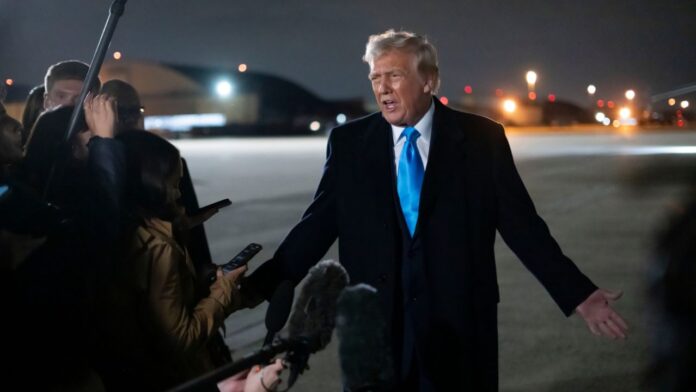President Donald Trump has used executive authority to slap additional tariffs on goods from Canada, China, and Mexico.
The decision fulfills campaign pledges, but it has also spurred retaliatory steps that might foreshadow a lengthy trade war with major trading partners, including Mexico and Canada, the United States’ closest neighbors and friends.
Unlike during the 2024 campaign, when Trump touted his economic policy as a certain method to decrease Americans’ living costs, the president now admits what many analysts have long predicted: the taxes might result in higher prices and reduced supply throughout the market.
Here’s what you need know about Trump’s moves, the reactions from US trading partners, and what it implies for American consumers:
The measures impact the three main US trading partners.
Trump declared an economic emergency, imposing 10% tariffs on all Chinese imports and 25% on goods from Mexico and Canada. Energy imports from Canada, such as oil, natural gas, and electricity, would be taxed at 10%. The tariffs on the United States’ three main trading partners will take effect on Tuesday.
Tariffs apply across the United States market. Examples include Canadian oil and timber, Mexican vegetables, apparel, liquor, and car components, and Chinese plastics, textiles, and computer chips.
Trump’s directive included no mechanism for providing exceptions to US importers.
To highlight the possible consequences, Canada exports more than 4.3 million barrels of oil to the United States each day. According to the Energy Information Administration, the United States consumes around 20 million barrels each day. Its domestic production has been at 13.2 million barrels per day.
Trump believes these taxes are about immigration and narcotics, downplaying the economy.
As a candidate and for decades before entering politics, the president frequently discussed the United States’ trade imbalances. He criticized international trade agreements and lamented the gradual transfer of manufacturing employment from the United States to other countries. However, he has portrayed his most recent moves as a means of gaining leverage over immigration and narcotics. Trump blames the three US partners for not doing enough to stem the flow of fentanyl into US markets. He blames Mexico and, to a lesser extent, Canada for the influx of migrants across the US border.
“It is my duty as president to ensure the safety of all,” Trump said on social media.
Canada, China, and Mexico have replied.
Trump’s directive contained a pledge to increase duties if US trading partners responded with their own. The danger did not deter a quick response.
Mexican President Claudia Sheinbaum quickly imposed retaliatory duties, while Canadian Prime Minister Justin Trudeau announced that he would impose 25% tariffs on up to $155 billion in US goods.
Trudeau advised Canadians to “choose Canadian products” when shopping, thus advocating a boycott of American goods. Locally, some Canadian provincial premiers announced that American alcohol brands will be completely removed from government shop shelves.
As of Sunday afternoon, China has not levied more tariffs on US imports. However, the Ministry of Foreign Affairs stated that the Beijing government will take “necessary countermeasures to defend its legitimate rights and interests.” The Ministry of Commerce stated that it will initiate a case with the World Trade Organization over the “wrongful practices of the US.”
Consumers will see the consequences, even if corporations pay the actual tariffs.
End-users do not pay tariffs directly. It typically refers to the corporation that transports items across the border, whether it is a foreign-based exporter or a U.S-based importer. However, this adds to the overall cost of bringing products to their final retail destination, and each player in the process is bound to raise their pricing as a result.
According to Gregory Daco, chief economist at the tax and consultancy firm EY, tariffs would boost inflation by 0.4 percentage points this year, up from 2.9% in December. Daco predicts that the US economy, which increased 2.8% last year, will shrink by 1.5% this year and 2.1% in 2026.
The Budget Lab at Yale University predicts that Trump’s tariffs would cost the average American household $1,000 to $1,200 in yearly purchasing power.
Even firms and items labeled “made in the U.S.A.” are affected. Because sometimes the label just indicates that a product is built or otherwise completed in the United States while still including raw ingredients, components, or packaging from abroad.
And, as Trump frequently stated throughout the campaign, energy prices, which become transportation costs in the supply chain, influence consumer pricing. Given Canada’s contribution of the United States’ energy supply, gas prices may rise, particularly in the Midwest, where so much Canadian crude oil is processed.
Trump has altered his tune over the consequences for consumers.
Candidate Trump made grandiose, outlandish claims about the US economy.
For example, he vowed to reduce grocery costs “immediately” and power rates by half within a year of assuming government. He consistently portrayed the Biden administration as a failure due to inflation and sought the support of Americans dissatisfied with the rising expense of living.
In an appearance with Fox News’ “Sunday Morning Futures,” Vice President JD Vance said that Trump’s initiatives will result in “more take-home pay” for American workers.
Trump is now retracting such remarks.
“Will there be any pain?” “Yes, maybe (and maybe not),” Trump tweeted Sunday morning. “But we will make America great again, and it will all be worth the price that must be paid.”
